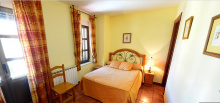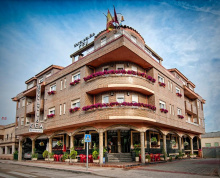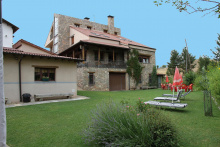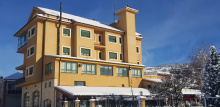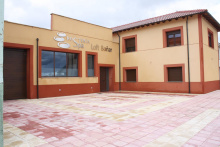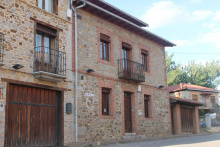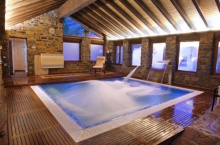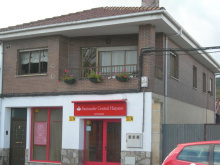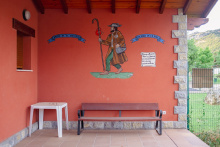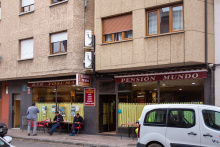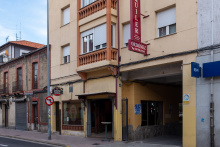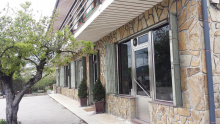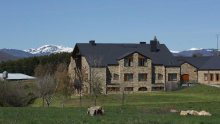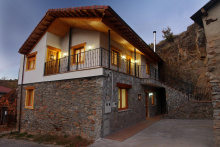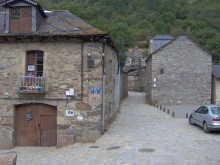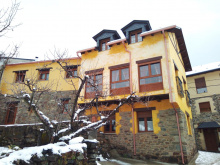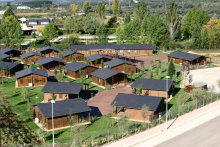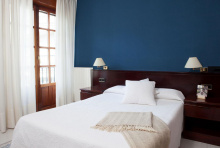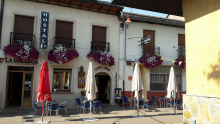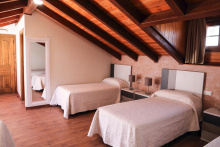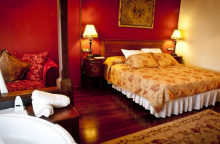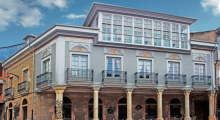OPTION 1
OPTION 2
Accommodation in Velilla del río Carrión
| Casa Rural Anti | |
| Casas Rurales Casán |
Accommodation in Morgoviejo
| Casa Rural La Mata |
Both routes rejoin in Puente Almuhey
In Puente Almuhey, there was a municipal albergue, but it was closed upon a complaint filed by the owner of the town’s hotel because of its lack of accessibility. Maybe I’m a cynic, but I’m betting she did not have the needs of disabled pilgrims in mind. Upon Ender’s recommendation, we went to El Duende de Carricuende. The owners are super, really trying to accommodate pilgrims. We had a fabulous 2 bedroom apartment for 15 or 20 € each. They also run a restaurant/bar next door, and it is a fairly big notch above your average camino restaurant, a bit of a foodie place in fact. We had a great meal here.
If I remember correctly, an early morning breakfast in the bar was inclued in the price.
Day 11. Puente Almuhey to Cistierna (21 km)
This is a five star day, one pilgrim put it this way: “In fact if I wanted to show someone the essence of a camino I would take them on this stage. It has everything — gentle stroll through pastures with the donging of cow bells, woods and forests. Good tracks, including a little bit of very quiet road, rural tracks, forest trails and the equivalent of goat trails! There are panoramic views, picturesque churches ad a sanctuary as well as pretty lakes.”
Don’t miss the mermaids on the wall of the Romanesque church in San Martín de Valdetuéjar. Legend has it that several peregrinas on the way to Santiago seduced some of the monks (yeah, yeah, blame the women). The enraged abbot turned the peregrinas into mermaids and threw them into the river. He then ordered the monks to build the church of San Martín, adding the carved stone mermaids as a reminder of their sins.
The 17C Sanctuary of Our Lady of La Velilla (established as a pilgrimage site in honor of her many miracles) has never been open when I walked by but it is a nice spot and has a Santiago Matamoros on one end of the building.
From there, a not-too-severe ascent begins and it is beautiful. Wild country at its best, with some well-known León mountain peaks in your sights. There is some road walking at the end, inevitable as you are entering what used to be a big mining town and is now a sad remnant of its former self.
This is a hard day to break up. The online resources list Hotel la Velilla, in Mata de Monteagudo near the Velilla sanctuary. That would be a good way to cut the day almost in half, and leave the ascent for when people are fresh in the morning. But its website is no longer functioning. I will do some more research, and see if there are any other ideas out there.
Accommodation in Puente Almuhey
Don’t miss the mermaids on the wall of the Romanesque church in San Martín de Valdetuéjar. Legend has it that several peregrinas on the way to Santiago seduced some of the monks (yeah, yeah, blame the women). The enraged abbot turned the peregrinas into mermaids and threw them into the river. He then ordered the monks to build the church of San Martín, adding the carved stone mermaids as a reminder of their sins.
Accommodation in San Martín de Valdetuéjar
| Casa Rural Casa Lara |
Accommodation in La Mata de Monteagudo
| Hotel Rural La Velilla |
Since the Olvidado and the Vadiniense cross here, I have spent three nights in Cistierna — once in the albergue (which was fine) and twice in the Hostal Moderno (small basic hotel, wonderful staff, do not miss their restaurant’s menú del día). I’ve told this story before, but when I checked into the Moderno in 2019, the women at the desk, said — oh I remember you, I once pulled a tick out of your back! And she was right, but it was five years earlier.
People are very nice in this town, and there is a park/playground up the hill beyond the albergue where many gather in the afternoons. Lots of cafés along the main street. I remember one place coming into town on the right, next to a “tienda de chinos” where the owners served great little Chinese food tapas with the drinks. That is not a common occurrence in Spain!
Day 12. Cistierna to Boñar (28 km)
Ender’s guide shows two different routes from Cistierna, both of which meet up in La Ercina. We could not find the way for the longer route, but one pilgrim reported — “The new version of the Olvidado goes uphill to San Pedro de Foncallada, 1-2 km longer than the flatter version, but very pretty. And then the necessary 2-3 romanesque or later churches to keep you going.”
Even on the “old route,” the first part of the walk is quite nice. When you go over the río Esla right after leaving town the Vadiniense/Olvidado split is well marked. This is a mostly flat day as you transition from the mountains behind Cistierna over to the mountains behind Boñar.
Stopping before Boñar
1: La Ercina
About 11 km beyond Cistierna is La Ercina, with an albergue. Tel 987 712 051/648 032 831.
La Ercina an ethnographic museum. It looks like a collection of old work implements, some from mining (along with a tribute to the “Ercina 14” who must be miners who died in the mines.
Since it is a rather short day, I did some hunting around to find ways to fill in the time, and it looks like there is a very nice route to visit some old castros (hill forts). Wikiloc shows several short routes — an 8 km circle. And this one with some nice photos of the views from the top.
2: Santa Colomba.
If 11 km is too short, I think the slightly off-route Hotel Rural Monasterio de Ara-Mada looks very nice. It in the village of Santa Colomba de las Arrimadas,
The owners are actively involved in promoting the Camino Olvidado. Their website shows a map and describes a 15 minute walk from La Devesa to their hotel. This would be about a 22 km day.
OPTION 1
OPTION 2
Both routes rejoin in La Ercina
Accommodation in La Ercina
| Albergue Municipal La Ercina |
There are a couple of pensiones in Boñar, but I have stayed only in the Nisi. The pensión rooms are on the top floor. On the floor below, the owner of the pensión offers rooms and care to old folks without resources or family. As I understand it, she uses the money from the pensión and restaurant below to support those who live there. She is no spring chicken herself, and is constantly on the go to take residents to doctor’s appointments, etc. All services available in Boñar.
Day 13. Boñar to Vegacervera (27 km)
In Boñar the camino splits and offers two options. One is typically walked in three stages and goes through mountains (Boñar-Vegacervera-Buiza- La Magdalena) and one is typically two stages and avoids the mountains (Boñar - La Robla - La Magdalena). I will start with the mountain route and then go back and review the alternative.
Mountain Route
This is a totally gorgeous 5 star day, at least if you ignore the last 8 km or so, which is on the side of the road from Correcillas. Actually, even that last part is very pretty, no traffic at all, it’s just that it’s on pavement.
The walk is off road at the beginning, really pretty, up to the small town of La Mata de la Bérbula, where there is a café. From La Mata to Correcillas, it is only 6 km, but it is one of those jaw-dropping but steep ascents — as you huff and puff up, you suddenly arrive at the top and the view just spreads out in front of you. It is really spectacular, the valley you ascended is there behind you, and real mountain peaks in front of you. We soaked it in for a long long time.
Not too far away from the high point, there is also a little chapel, the Ermita de San Froilán. I have been unable to find instructions on how to get there from the Camino Olvidado. All I see are routes going there from the town of Valdorria below. I hope @alansykes will be able to help us out here. On one of his walks, I know he did not go up to the ermita, but did photograph it from below. But he has also posted a picture from the ermita, so I am pretty certain he has actually walked up there on a return visit to the stage from Boñar.
Lots of shade and beautiful views on the descent, too!
Now, for those who don’t want to undertake this stage in its entirety, but would like a glimpse of what is truly mountain glory, you could consider taking a taxi from Boñar to La Mata de la Bérbula (16.5 km from Boñar). You will miss one of the ascents, but the views are not nearly as spectacular as the one after La Mata. It’s a huffing and puffing ascent — about 300 m in a kilometer or two, but if slow but steady works for you, consider this option. It would give you a day of about 12 kms, and after the big ascent, it is downhill (not too drastic an incline) and then pretty flat into Vegacervera.
There are also two towns with accommodations on this stage,
Ranedo de Curueño, about 8 km from Boñar, has a rural hotel,El Canto de Gallo.
Valdepiélago, which is about another km on, has several Casas Rurales. One of them is for two people and shows a price of 75€.
If you had stopped short of Boñar on the previous stage, in the Hotel Monasterio Ara-Mada, you would have a total of about 15 or 16 to one of those two places. That would mean a 20 km day to Vegacervera.
Day 13. Boñar to La Robla (33 km)
This is the other option from Boñar, the flat option. Both meet up in La Magdalena after a fair amount of road walking.
The last kms into La Robla were quite nice, and off-road, at least till the big factory came into view!
For shorter distances, there are several ways to spit the stage.
Abut 9.5 km from Boñar — In La Vecilla, Hostal Las Hoces).
About 14 km from Boñar — The albergue in Aviados, Albergue Fuente de Oso. They have confirmed via WhatsApp that they take in pilgrims for a night, but reserve in advance. Tel. +34 666 60 58 35
About 20 from Boñar — The online Camino Olvidado website lists a hotel in Robles de la Valcueva, the Hotel Rural el Arriero. No website that I can find, though it does come up on google maps.
About 25 from Boñar, in Candanedo, Hostal el Valle. Actually, a stop here would position you for an approximately 24 km day the next day to La Magdalena.
Accommodation in Boñar
OPTION 1
Accommodation in Ranedo de Curueño
| El Canto del Gallo Booking.com |
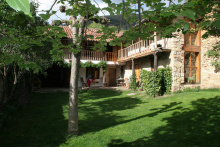
|
Accommodation in Valdepielago
| Casas Rurales La Maestra y El Refugio |
In Vegacervera, we stayed at the Albergue El Chaltén, whose owner is a real Camino supporter. The albergue is actually a group of cabins with bunks for about 12-16. There was a youth group there when we arrived, occupying about five of the cabins, and they put us in our own, away from all the excitement. It’s a very nice set-up. When the albergue is full, the owner will take pilgrims into his own home — he explained that he had promised Ender to take care of pilgrims and he will.
The Hotel Chousa Verde is supposed to give a good pilgrim rate, but @MikeJS was unable to get anything but a high priced room.
Ender took us to what is undoubtedly the best place to eat in this little town, kind of out of the way. The name is Mesón La Cocinona, and it is affiliated with a family-run embutidos factory. That may not be a ringing endorsement for vegetarians or vegans, however.
For those who like yoghurt, I cannot recommend the Coladilla yoghurt enough. It is made in a hamlet of that name (you pass through on the camino about 2 km after Vegacervera). The young owners took over the family operation and decided to go “artisanal.” They make a goat milk yoghurt that is just unbelievable. Though there are no grocery stores in Vegacervera, a couple of the embutidos factories have little stores selling their sausages and dried meats, along with a few grocery items. We found some for sale, along with some fruit, chocolate and “frutos secos” in one of them.
Day 14. Vegacervera to Buiza (16) or Pola de Gordón (24)
This is another great day, with one very difficult (some would say dangerous) descent, but it can easily be avoided. Another day where the GPS came in very handy.
It is very pleasant countryside as you leave town. You pass through Coladilla with its creamery. The route from Coladilla to Villar was along an untraveled road for us, but this is where Ender has moved it off-road and it is apparently very nice.
In the town of Villar, about 7 km from Vegacervera, there is a hairy descent. It’s not a path, just a bunch of sharp jagged rocks that you have to pick your way over. I think it took us about 30-40 minutes to descend what is probably about 100 m, though I am a bad judge of distance.
What I would recommend is that you go out from Villar to the start of the descent — it’s very close to the road — and then judge for yourself. If it looks hairy, go back to Villar and take the 5 km road walk into La Vid de Gordón.
There was some forum chatter about this a while back, and you should take a look at the video at the point I indicated in a post on it.
@alansykes did this descent in the pouring rain. I absolutely cannot imagine that. Here’s what he said: “Very lovely but the most difficult of my 500+ camino days thanks to the driving rain and almost sheer descent.”
If you can take the descent, you will be rewarded by a stroll through the gorge at the bottom, a truly beautiful beech forest, and a chance to see some abandoned mines.
The first town you come to after the descent is Ciñera. There are bars, and a mine elevator sitting in the plaza with the plaque saying — it wasn’t an accident, it was a murder. This refers to a mine explosion, caused by a methane leak (I think that’s the approximate translation of grisú) in which 6 miners were killed in 2013.
La Vid is just a short hop and a jump beyond Ciñera. It is another mining town and has a lot of what looks like “company housing,” now decorated with street art and looking a lot jazzier. You will rejoin the camino here if you took the road alternative from Villar.
Between La Vid and Buiza, the markings are few and the path can be unclear. Nothing dangerous, and you are unlikely to get too far off track because you know the general direction, This was another one of those spots where my GPS just couldn’t give me enough detail at the micro level, so we found ourselves wandering around a bit. But we never felt lost.
Once in Buiza, you can stay at the albergue there (but you should have food with you), or continue on the 7.5 km to Pola de Gordón. It’s all road, but very little traffic.
Accommodation in Vegacervera
| Albergue Valporquero |
| Camping Las Hoces |
| Casa Rural La esquina (I y II) |
| El Chaltén |
| El Molino de la Ropería Booking.com |
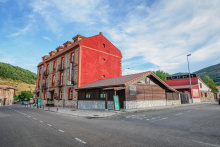
|
| Chousa Verde |
Accommodation in Buiza (via Olvidado)
| Albergue de peregrinos de Buiza 5€ 12 |

|
Pola de Gordón is a town with some services, groceries, a couple of pensiones and bars/mesones. Two hotels have closed, one recently, and the other many years ago. Both Pola de Gordón and Buiza are on the Camino del Salvador, which goes from León to Oviedo. If you plan to switch over to the Salvador, as @MikeJS did, you should stay in Buiza. Pola de Gordón is to the south, taking you back towards León. So if you sleep in Pola de Gordón, you will just have to return the 7 kms to Buiza the next day. I have found a nice looking CR in Buiza, but they don’t seem to do one night stays or rent by the room.
I have spent three nights in Pola de Gordón, and have slept twice in the rooms above the Mesón de Miguel, and more recently in the Pensión 15 de Mayo. Neither of these is special, but they are both perfectly adequate — cheap, less than stellar beds, decent bathrooms, clean sheets, all in all perfect pilgrim places. Mesón de Miguel is a decent place for an adequate meal.
One taxi in Pola de Gordón, just in case anyone needs it. Álvarez Suárez, tel. 987 586 058
Accommodation in Castillo de Piedrasecha
| Casa Rural Los Calderones (I y II) | |
| La Parra |
OPTION 2
Accommodation in Robles de la Valcueva
| Hotel Rural El Arriero |
Accommodation in Candanedo de Fenar
La Robla has a good restaurant, Mesón La Bogadera, stores and cafés. The pilgrim’s albergue is excellent, and there is a pensión in town.
Day 14 bis — La Robla to La Magdalena (16 km)
I went from La Robla to Pandorado when I walked the first time, but a stop in La Magdalena makes for a perfect shorter day. Either 16 from La Robla, or 24 from Candanedo. I‘ve discussed lodging in Magdalena on the mountain alternative thread, so unless anyone has found something new, I think we have that covered.
The first thing you see leaving La Robla is a big mine. You will pass through several little villages, clearly struggling as the mining industry has totally collapsed. The first time I was in La Robla, there were huge banners flying from the Ayuntamiento — Save Coal Mining!!! Even then I think the writing was clearly on the wall, but they were still fighting. Ender was a mining engineer, and I think part of what energizes him is the thought that these caminos might bring back some semblance of prosperity if enough people walk them.
When I walked this part in 2014, I noted repeatedly that the villages had three types of houses — those that were abandoned and in ruins; those that were totally renovated and beautiful but locked up tight; and those that were habitable, sometimes just barely, but with real people living there. There is something sad about a town where the summer visitors live much better than the people who are there all year.
This is not a particularly remarkable stage, but I do remember a long chat with a woman who stopped on the highway to see if I was ok and to find out what I was doing. Her husband was a retired coal miner and they were sadly watching the whole area collapse. Her children live in León capital and they have been begging them to move there, but she says — NUNCA! I wonder if she is still there 7 years later.
Some more mountains coming up, so having a few flat days is not a bad thing!
Accommodation in La Robla (Olvidado)
Both routes rejoin in Otero de las Dueñas
Day 16. La Magdalena to Pandorado (20 km)
(For anyone who notices that the last stage I posted was numbered 14bis, this stage gets the number 16 because the mountain alternative through Vegacervera took three days from Boñar to La Magdalena, while the “bis” route took only two).
For those who want longer stages, the most obvious stop would be Vegarienza, which is about 28 km from La Magdalena, and which has a wonderful albergue above the medical office, and a very nice road-side restaurant. But I’ll stick with Pandorado as the end point.
This is another one of those idyllic off-road stages, not much in the way of dramatic scenery but very pleasant. Pine forests and oak forests. Some of the camino goes along the Transhumancia, the official “livestock path” for farmers to take their flocks down to Extremadura during winter months. Though the animals are now transported by motorized vehicles, I remember being in Madrid in the 70s when the streets were closed off for one day. Some animals paraded on through the center of the city, to the delight of many and the displeasure of some. (Sort of the same reaction you get when cities are closed for marathons or cycling races).
I don’t remember any open bars or other services aside from those at the beginning in La Magdalena, and a café in Riello, about 17.5 km further along.
Ender actually lists Riello as the “end of stage” but I don’t see any accommodation there. The casa rural I have contacted has advised me it’s a whole house rental with a minimum of two days. But there is a nice bar there, with an outdoor café. This was another one of those places where the local residents were eager to talk to me about the camino, their pueblo, and their hopes for a better future. Carrying on from Riello to Pandorado is another 2.5 km and involves an ascent, but it isn’t dramatic.
Resthy’s place in Pandorado is a small complex. It has a bar/mesón, restaurant, and tourist apartments (with washing machines!). They are very familiar with peregrinos. Ender’s guide doesn’t list it, and that may be because they have been a bit uncooperative with accommodating pilgrims. When I stayed there in 2014, there were no others spending the night in their nice tourist apartments, and the price for me was a whopping 60€. The owner told me the price was the same for 1, 2, 3, or 4, and I was free to invite in some others. He and his wife were very nice, they just were not there to help pilgrims out. At that time, they also had a kind of taxi service. If the next day you walked to Fasgar or to any place before that, they would come pick you up and bring you back to Resthy’s. Cost was in the 20s€ I believe. But of course you would have to pay another fee to get taken the next day back to your starting point. That would make for 160€ for two nights plus taxi, not to mention food. That is no longer necessary, as there are places to stay now, but back in the day they had a kind of monopoly going on.
There is also a Gran Hotel Pandorado across the street from Resthy’s, so maybe that has made him offer more competitive prices. The hotel was not open when I walked through in 2019, and it doesn’t seem to have a website. Booking says it is not taking reservations.
All in all, I think this is a very manageable and enjoyable 20 km day.
Accommodation in La Magdalena (León)
Ender actually lists Riello as the “end of stage” but I don’t see any accommodation there. The casa rural I have contacted has advised me it’s a whole house rental with a minimum of two days. But there is a nice bar there, with an outdoor café. This was another one of those places where the local residents were eager to talk to me about the camino, their pueblo, and their hopes for a better future. Carrying on from Riello to Pandorado is another 2.5 km and involves an ascent, but it isn’t dramatic.
It's perhaps worth mentioning that the tienda in Riello is the last one before Iguëña, 46km further on, and other food options are scarce. Especially if the lovely restaurant in Vegarienza (the oldest in León province) closes, and if you hit Fasgar when Aires de Fasgar is closed (which it is roughly 300 days a year).
Accommodation in Riello
Resthy’s place in Pandorado is a small complex. It has a bar/mesón, restaurant, and tourist apartments (with washing machines!). They are very familiar with peregrinos. Ender’s guide doesn’t list it, and that may be because they have been a bit uncooperative with accommodating pilgrims. When I stayed there in 2014, there were no others spending the night in their nice tourist apartments, and the price for me was a whopping 60€. The owner told me the price was the same for 1, 2, 3, or 4, and I was free to invite in some others. He and his wife were very nice, they just were not there to help pilgrims out. At that time, they also had a kind of taxi service. If the next day you walked to Fasgar or to any place before that, they would come pick you up and bring you back to Resthy’s. Cost was in the 20s€ I believe. But of course you would have to pay another fee to get taken the next day back to your starting point. That would make for 160€ for two nights plus taxi, not to mention food. That is no longer necessary, as there are places to stay now, but back in the day they had a kind of monopoly going on.
There is also a Gran Hotel Pandorado across the street from Resthy’s, so maybe that has made him offer more competitive prices. The hotel was not open when I walked through in 2019, and it doesn’t seem to have a website. Booking says it is not taking reservations.
Day 17. Pandorado to Fasgar (26 km)
If you have slept in Pandorado, your choices are either Vegarienza (8) or Fasgar (26). There is just nothing in between Vegarienza and Fasgar. The road up to Fasgar through the valley has lots of tiny little villages, all looking like great vacation spots, but no accommodations that I can find!
Leaving Pandorado, there is an initial descent along an untraveled road to the pretty town of Omañuela and its river. From there it is really a pretty walk, a very gradual ascent, lots of river walking. There is nothing in the spectacular range, but there are ancient bridges, a few bits of Roman Road, a couple of tiny towns. Not much in the way of places to eat or drink, unless you are walking when the pueblos have “reopened” for summer, so bring what you need. Even in summer, the bars are unlikely to open in morning or early afternoon. It is almost totally off-road, so the feet enjoy the surface and the mind enjoys the quiet.
About 8 km after Pandorado, you come to the tiny hamlet of Vegarienza. Estela is a woman who grew up in the village, worked in Madrid, then retired and came home to take care of her ailing brother. Her house is two doors down from the medical center, and she noticed that it had a top floor that was not being used. With the help of other Olvidado supporters, she was able to get the top floor converted into a very nice albergue. She has the keys, will check you in, and is a gem. Her love is directed at her village, not at the Camino, and she fervently hopes the albergue will help bring back some life.
******
If you like longer stages, La Magdalena to Vegarienza is about 30. I stayed here in 2019 and it was really very nice. The little restaurant on the road was open for lunch, so I had my main meal here. It was pretty astonishing to see an elderly woman and her daughter (and by elderly I mean over 90!) doing all the cooking, serving, and cleaning. The set-up gave you a front row seat to the action, because the kitchen is in the middle of the restaurant. The mother told me they had been trying to retire for years now, but can’t bring themselves to shut the place and leave the village and the surrounding area with nothing. Googlemaps tells me Restaurante Maxi is currently open for takeout, a good sign for post-pandemic walkers!
******
But back to the route to Fasgar. Shortly after leaving Vegarienza, you take a left turn off the LE-493. You are now on a small road that ends in Fasgar. The camino is mainly off road, but the road is never far away. It goes through several small villages, all along the river. Just so pretty. I had a cow encounter or two, and those who are leery could just stay on the road, because it is very very untraveled. The only advice I would definitely give is to make sure to take the camino path from Vegapujín into Fasgar, it is lovely and no cows!
On my first Olvidado, Rosi opened her home to me, thanks to Adolfo (from Nava de Ordunte). Rosi had recently moved back to her pueblo from Oviedo, where she was on the hamster wheel of living pay check to pay check with a young child and high child care costs. When I first met her, she was running the “social center” (municipally owned bar). But basically they were living “off the grid” — with their own garden plots, a few animals (with an annual pig slaughter), wood stove. At that time the year round population was about 8, and it was the 3rd birthday of Rosi’s daughter, which I was privileged to celebrate with them in the bar.
Fasgar, at the end of the road, is a beautiful little mountain village, which fills up in the summer. Winters are hard, no more than 10 full time residents, and Rosi told me of many weeks with no outside contact. During her first winter back, she counted the days with snow and then got discouraged and stopped counting. It must be beautiful, but almost inaccessible.
Fast forward a few years, there is now an albergue in the old school, a slightly fancy restaurant, and a Casa Rural, all run by Rosi. I would highly recommend a stop here, no matter where you stay the night before. The restaurant seemed wildly successful the last time I was there. In fact, checking today on their website, I see that the weekend is completely booked for the restaurant, and this is a Tuesday during a pandemic!<
If 26 km is too much for you, the only obvious options I see are to either take Resthy up on his taxi offer for part of the way, or break the stage up into 8 (to Vegarienza) and 18 (to Fasgar).
It is a lovely stage, ending in a really pretty little town with a river running through it. It is literally at the end of the road.
Accommodation in Pandorado
About 8 km after Pandorado, you come to the tiny hamlet of Vegarienza. Estela is a woman who grew up in the village, worked in Madrid, then retired and came home to take care of her ailing brother. Her house is two doors down from the medical center, and she noticed that it had a top floor that was not being used. With the help of other Olvidado supporters, she was able to get the top floor converted into a very nice albergue. She has the keys, will check you in, and is a gem. Her love is directed at her village, not at the Camino, and she fervently hopes the albergue will help bring back some life.
Accommodation in Vegarienza
| Casa de Acogida |
On my first Olvidado, Rosi opened her home to me, thanks to Adolfo (from Nava de Ordunte). Rosi had recently moved back to her pueblo from Oviedo, where she was on the hamster wheel of living pay check to pay check with a young child and high child care costs. When I first met her, she was running the “social center” (municipally owned bar). But basically they were living “off the grid” — with their own garden plots, a few animals (with an annual pig slaughter), wood stove. At that time the year round population was about 8, and it was the 3rd birthday of Rosi’s daughter, which I was privileged to celebrate with them in the bar.
Fasgar, at the end of the road, is a beautiful little mountain village, which fills up in the summer. Winters are hard, no more than 10 full time residents, and Rosi told me of many weeks with no outside contact. During her first winter back, she counted the days with snow and then got discouraged and stopped counting. It must be beautiful, but almost inaccessible.
Fast forward a few years, there is now an albergue in the old school.
The Aires de Fasgar Rural House and its restaurant have closed.
Day 18. Fasgar to Igüeña (18 km)
On my first Olvidado in 2014, this stage was heralded as the “etapa reina” (jewel in the crown more or less) of the Olvidado. It is beautiful, no doubt about it, but it now has some stiff competition from the Boñar-Vegarienza-La Magdalena variant. But if the weather is good, you are in for some exhilaration.
You ascend on a dirt road from Fasgar, then go down and cross the Campo de Santiago, where Santiago appeared in 981 to help defeat the Moors. I wrote a short synopsis of the story for Ender’s guide and won’t repeat it here, but the bottom line is that thanks to Santiago’s intervention, about 70,000 Moors lost their lives on this battlefield.
From the ermita at the bottom commemorating the battle, you continue on a beautiful trail along the river. There is uneven footing in places, but the wooden bridges back and forth over the river have been rebuilt since the first time I walked on very precarious wooden structures.
The camino emerges a total of 12 kms later from Fasgar in the town of Colinas del Campo de Martín Moro Toledano (the leader of the Moors in the famous battle). This is the town with the longest name in all of Spain, and it is another beautiful mountain village, just beautiful. Only a bar or two, seasonal hours, so don’t count on much. The first time I walked through nothing was open, but the second time was a Saturday and I was able to enjoy a nice cold drink in a very lively mesón with terrace.
The fun fact is that the walk from Fasgar to Colinas del Campo is 12 km on foot. Driving a car turns it into a 79 km ordeal.
From Fasgar, the rest of the way into Igüeña is along the river, usually off road and very pleasant. All shaded! Igüeña has a modern albergue run by the bar/restaurante that is adjacent, and the owners will cook you up a plato combinado at any reasonable hour.
The mural at the entrance to town makes a big impact and reminds you that you are still in the part of Spain that is struggling to find life after mining.
If 18 km is too short for you, here are a couple of other ways to break it up.
Vegarienza to Igüeña is about 35 or 36. But you would not get a stop in Fasgar, which is surely a pity. Beyond Igüeña, Quintana de los Fuseros and Labaniego have options.
Accommodation in Fasgar
| Albergue Turístico La Escuela 5€ 10 |
Day 19. Igüeña to Labaniego (19 km)
The mountain walking is now officially over, but I remember some nice walking tracks through logging forests and just generally pleasant terrain. Nice views, nice paths. The hills of the Bierzo are on your left and there are vineyards and other agricultural production.
About 7 kms beyond Igüeña is the small town of Quintana Fuseros. On my first Olvidado, I arrived too early from Fasgar to stop in Igüeña and decided to keep on walking. When I got to Quintana Fuseros and went into the bar, the bar owner made a phone call and the mayor came down to meet me. After welcoming me to town and buying me a drink, he proceeded to call the owner of the casa rural. She had a neighbor open the house and left me the run of the place. She asked me to leave 20€ on the table. It’s not much of a town to look at, but the people are wonderful. The home was clean, modern, hot showers and good kitchen. But bring food because there’s nothing in town.
After Quintana Fuseros, as you are ascending to a forest, you’ll see a broken crucifix. The Cruz Cercenada represents the cross that was broken by Almanzor’s sword during a 10th century battle in the area. I think the idea is to turn it into something similar the Cruz de Fierro but I didn’t see any evidence of that.
Another 12 kms and you are at Labaniego. I have never stayed here, but Ender’s guide indicates there is “acogida de peregrinos.” This term means that you will find a place to sleep but no guarantees about bed or showers or hot water. Labaniego also has several casas rurales, and a couple are offered on booking.com. It’s a small place, several nicely restored homes, but no services of any kind that I can see on google. So I would be sure to bring food.
If you can walk 5 more kms, there is a small Hostal/Bar in Losada. On my last walk through, it was a terribly rainy day. I very much enjoyed a long stop and two hot cafés con leche. Wonderful people. You can tell a lot about a person’s character by her reaction to the entrance of a dripping wet pilgrim. Total hospitality, no worries about the puddles!
Accommodation in Igüeña
On my first Olvidado, I arrived too early from Fasgar to stop in Igüeña and decided to keep on walking. When I got to Quintana Fuseros and went into the bar, the bar owner made a phone call and the mayor came down to meet me. After welcoming me to town and buying me a drink, he proceeded to call the owner of the casa rural. She had a neighbor open the house and left me the run of the place. She asked me to leave 20€ on the table. It’s not much of a town to look at, but the people are wonderful. The home was clean, modern, hot showers and good kitchen. But bring food because there’s nothing in town.
Accommodation in Quintana de Fuseros
| Casa Rural El Caruzal |
Another 12 kms and you are at Labaniego. I have never stayed here, but Ender’s guide indicates there is “acogida de peregrinos.” This term means that you will find a place to sleep but no guarantees about bed or showers or hot water. Labaniego also has several casas rurales, and a couple are offered on booking.com. It’s a small place, several nicely restored homes, but no services of any kind that I can see on google. So I would be sure to bring food.
Day 20. Labaniego to Congosto (18.5 km).
I remember this day as having lots of beautiful views over the Bierzo region to my left. At some point the terrain changes to vineyards, but before that it is green and even lush. My memory is not exactly tracked with these stages, because these are not the stages I walked. These last few days into Ponferrada are very pleasant, because you are now firmly implanted in the Bierzo, which IMO is a gorgeous part of the country.
Such a contrast between houses, some beautifully preserved, apparently on their last legs.
In Cobrana, about 13 km beyond Labaniego, I slept in La Vieja Fragua. It’s a tiny house with a loft, and the owner rents to peregrinos. The bar owners are in charge, since the owner lives out of town, but a WhatsApp is easy to set things up. Gelines in the bar prepared me a “lunch” that was too much food for lunch AND dinner. She delivered it to the house after I was showered and dry. It had been one of those almost all-day rains. I can’t remember what it was, but I do remember some excellent cheese, bread and sausage on the side. In the afternoon, the rain let up, and I enjoyed some good time with locals who are, as seems to be generally the case along the route, hoping very much that the Camino Olvidado becomes more popular.
From Cobrana to Congosto is forest with beautiful chestnut groves. Before you get to Congosto, there is an ascent to the Sanctuary of the Virgen de la Peña. As a dutiful peregrina, I walked up, but it was thick pea soup fog and there were no views to be had. But the views would be over the Bárcena Reservoir, and frankly, I have come to the conclusion that I just don’t much like reservoirs. Cañaveral, Arija, Aguilar de Campoó, and now Bárcena. All of the reservoirs I have walked by strike me as slightly depressing for some reason.
I have only slept in Congosto once, and it was on my first Olvidado when I once again was saved by the kindness of others. I called several casas rurales, and the owner of the Casa Rural Álvaro de Mendaña moved mountains to get her house opened for me. She was leaving town at noon be in Ponferrada for an appointment, but she prevailed upon her brother to open up the house when I called upon arrival. On the table were a bowl of cherries and some home made cakes. And the brother told me his sister had said to just leave whatever I thought was an appropriate amount. Highly recommended, though I would recommend giving her a heads up more than a few hours in advance like I did!
The house is right across the street from a restaurant, where I was overjoyed to find a cheap menú del día at 5€ because I had almost totally run out of cash. Pola de Gordón (day 15) was the last ATM I had seen. Hopefully others can chime in with information about ATMs I might have missed. Luckily, the next day was Ponferrada, but I was close to penniless by that time.
Accommodation in Labaniego
| El Sardón I y II | |
| La Nogala Booking.com |
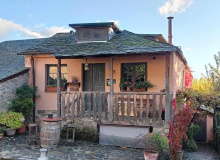
|
| Casa Rural Dora |
Accommodation in Arlanza
| El Mayulón |
On my last walk through, it was a terribly rainy day. I very much enjoyed a long stop and two hot cafés con leche. Wonderful people. You can tell a lot about a person’s character by her reaction to the entrance of a dripping wet pilgrim. Total hospitality, no worries about the puddles!
In Cobrana, about 13 km beyond Labaniego, I slept in La Vieja Fragua. It’s a tiny house with a loft, and the owner rents to peregrinos. The bar owners are in charge, since the owner lives out of town, but a WhatsApp is easy to set things up. Gelines in the bar prepared me a “lunch” that was too much food for lunch AND dinner. She delivered it to the house after I was showered and dry. It had been one of those almost all-day rains. I can’t remember what it was, but I do remember some excellent cheese, bread and sausage on the side. In the afternoon, the rain let up, and I enjoyed some good time with locals who are, as seems to be generally the case along the route, hoping very much that the Camino Olvidado becomes more popular.
From Cobrana to Congosto is forest with beautiful chestnut groves. Before you get to Congosto, there is an ascent to the Sanctuary of the Virgen de la Peña. As a dutiful peregrina, I walked up, but it was thick pea soup fog and there were no views to be had. But the views would be over the Bárcena Reservoir, and frankly, I have come to the conclusion that I just don’t much like reservoirs. Cañaveral, Arija, Aguilar de Campoó, and now Bárcena. All of the reservoirs I have walked by strike me as slightly depressing for some reason.
I have only slept in Congosto once, and it was on my first Olvidado when I once again was saved by the kindness of others. I called several casas rurales, and the owner of the Casa Rural Álvaro de Mendaña moved mountains to get her house opened for me. She was leaving town at noon be in Ponferrada for an appointment, but she prevailed upon her brother to open up the house when I called upon arrival. On the table were a bowl of cherries and some home made cakes. And the brother told me his sister had said to just leave whatever I thought was an appropriate amount. Highly recommended, though I would recommend giving her a heads up more than a few hours in advance like I did!
The house is right across the street from a restaurant, where I was overjoyed to find a cheap menú del día at 5€ because I had almost totally run out of cash. Pola de Gordón (day 15) was the last ATM I had seen. Hopefully others can chime in with information about ATMs I might have missed. Luckily, the next day was Ponferrada, but I was close to penniless by that time.
Day 21. Congosto to Ponferrada (16-19 km)
I am just planning on taking us from Congosto into Ponferrada, unless anyone thinks they would be interested in the Cabanas Raras route, which joins up with the Francés in Cacabelos. I know I’ve said this a million times, but if you are going to continue from here to Santiago, I think heading to Ponferrada and then walking the Invierno to Santiago is a terrific choice! With apologies to the dilligent Olvidado organization.
The official Camino Olvidado does not go down to Ponferrada, but rather continues for two more days to Cabañas Raras (20 km) and then onto the Francés at Cacabelos, with a stage ending in Villafranca del Bierzo (16 km from Cabañas). I have gone into Ponferrada both times, in order to get on the Invierno, which is a combination of caminos made in heaven. If you are going to continue on the Francés, though, Cabañas Raras is very eager to have pilgrims, and there is an “acogida” in town.
There are at least 2 ways to get from Congosto to Ponferrada. One is along the reservoir and across the dam. The spot where you leave the Olvidado to go into Ponferrada is obvious, but someone has tried mightily to erase the arrows showing the split. I would have a GPS just to make sure get on the right path, and there are many wikiloc tracks.
In 2014 I followed the arrows and it turned out to be a slightly convoluted loop. You walk alongside the reservoir, and cross over to the other side at the dam. It keeps you on the route to Cabañas Raras for a lot of the way, and then a cut south down to Ponferrada.
In 2019 I thought I was heading to the romanesque church I describe below, but got turned around and wound up in a pine forest. Luckily I came across a European Diabetic biking group, and they helped me get back on track. (And I ran into them the next day in Las Médulas!). The pine forest is a nice option for going into Ponferrada, but I’m afraid I can’t reconstruct it since I was lost.
On both occasions I joined the Francés at Columbrianos and then walked “backwards” to Ponferrada.
A second way into Ponferrada was brought to my attention after my last Olvidado. It is based on the idea that you want to go straight from Congosto to Ponferrada, rather than walk along the Olvidado route leaving Congosto and then detour. So this route leaves the Olvidado directly in Congosto. And it is a few km shorter.
This route will not take you to Santo Tomás de las Ollas, with its 10C Mozárabe church, unless you detour off the wikiloc tracks, near where the wikiloc map says “Urbanización Patricia.”
Alansykes was able to visit and enjoyed it immensely. He forged his own route, staying part of the way on the Olvidado and then turning off. Here’s what he reported:
Assuming you're planning on taking the Invierno into Compostela, I'd recommend leaving the Olvidado near the Bárcena reservoir and going straight into Ponferrada, rather than following the official route on to Villafranca del Bierzo. As well as saving a day or so, the main advantage is that you get to pass the glorious (possibly partly pre-)Romanesque/mozárabe church of Santo Tomás de las Ollas, with its amazing horseshoe arches and breathtaking almost circular simple apse.
I was sitting sadly outside thinking I would never see the interior when Manuela, a relatively elderly lady living in one of the houses on the square in front of the church came out with the key and let me in and gave me a lot of information about this fascinating site, including that it's just possible that it's of Visigothic origin. If Manuela isn't about, she told me that the local bar will let people know where she is, or find a key somewhere else (they're clearly justly proud if this hidden gem in the area). And then only a km or so into the centre of Ponferrada. "Vaut le detour", as the Michelin guides used to say.
The official Ponferrada website says to call the tourist office to see about getting someone to open it up. 987.42.42.36 Open every day except Monday.
So there you have it, the Olvidado from Bilbao to Ponferrada!
Accommodation in Congosto
Cacabelos is best known for the production of wine, you’ll notice a modern building at the start of town that was built to promote the region.
Take the time to wander the lateral streets and you will be rewarded with several out of the way restaurants. The municipal albergue here has a curious design; horseshoe in shape it wraps around the church and enjoys semi-private two person rooms.
Cacabelos owes its prosperity to the once Archbishop of Santiago de Compostela Diego Gelmírez who gave the instructions that it be rebuilt in 1108. Very few of the churches remain, but the Iglesia de La Quinta Angustia near the river houses a positively unique sculpture of Baby Jesus and Saint Anthony of Padua playing cards.
Although most of his men were drunkenly sacking nearby Villafranca, Sir John Moore’s retreating army scored a small victory here during the Battle of Cacabelos. One of his riflemen, the talented Thomas Plunket, managed to put a bullet in the head of the French cavalry Brigadier General Auguste Colbert from 500m, and another into the head of the officer that came to Colbert’s aid. The balance of the Peninsular War didn’t quite go to Moore’s advantage and following this victory he resumed his retreat towards A Coruña.
The camino leaves town along the road over the Río Cúa and past the church and albergue.
Accommodation in Cacabelos at the end of the Camino Olvidado
| Albergue de Cacabelos 6€ 70 |
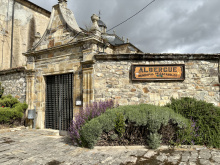
|
| Albergue La Gallega 13€ 26 Booking.com |
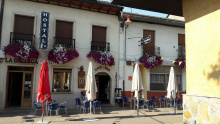
|
| Albergue-Pensión El Molino 15€ 16 |
|
| Saint James Way 22€ 15 Booking.com |
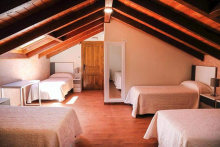
|


